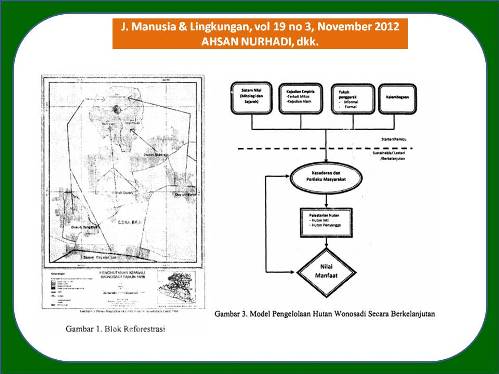
KEARIFAN LINGKUNGAN DALAM PERENCANAAN DAN PENGELOLAAN HUTAN WONOSARI KECAMATAN NGAWEN KABUPATEN GUNUNGKIDUL (Environmental Wisdom in Planning and Management of the Wonosadi Forest Ngawen District, Gunungkidul Regency)
Ahsan Nurhadi(1*), Bakti Setiawan(2), Baiquni Baiquni(3)
(1) UGM
(2)
(3)
(*) Corresponding Author
Abstract
ABSTRAK
Penelitian ini mengkaji tentang kearifan lingkungan masyarakat dalam perencanaan dan pengelolaan Hutan Wonosari, salah satu hutan adat yang terletak di Desa Beji, Kecamatan Ngawen Kabupaten Gunungkidul. Kearifan lingkungan dalam mengelola hutan adat telah mengakar kuat di tengah-tengah masyarakat disekitar Hutan Wonosadi dan bersumber dari adanya mitologi dan sejarah hutan. Proses pengelolaan Hutan Wonosadi telah berjalan sangat panjang. Pada kurun waktu Tahun 1960 s/d Tahun 1965 Hutan Wonosadi hampir musnah akibat penjarahan liar. Pada saat itu daerah disekitar hutanWonosadi mengalami kerusakan parah akibat banjir krakal dan tanah longsor apabila musim penghujan tiba. Melalui prakarsa perangkat desa beserta tokoh masyarakat, pada tahun 1966 diadakan perencanaan kembali Hutan Wonosadi (reforestrasi). Masyarakat bahu membahu mengimplementasikan rencana penghutanan kembali tersebut. Kegiatan ini setelah beberapa tahun lamanya telah mampu mengembalikan keberadaan Hutan Wonosadi. Adanya mitologi dan sejarah Hutan Wonosadi telah menciptakan banyak mitos yang dipercaya oleh masyarakat sekitar secara turun temurun. Kejadian empiris yang dialami oleh masyarakat terkait dengan mitos tersebut telah menjadikan masyarkat mempunyai keterkaitan secara batiniah untuk tetap menjaga kelestarian Hutan Wonosadi. Di samping itu, masyarakat juga menerapkan konsep kesadaran realitas dengan in=dionm tekun (sungguh-sungguh), teken (petunjuk), tekan (sampai pada hal yang dicita-citakan) serta konsep kesadaran mitologi sangkan paraning dumadi. Hutan Wonosadi telah memberikan manfaat yang sangat besar bagi penduduk di sekitar karena masyarakat mempunyaimempunyai kesadaran dalam kerangka mitologi dan realitas untuk mengelola hutan dan tetap ingin merasakan manfaat yang pisitif dari keberadaan hutan tersebut.
ABSTRACT
This study examines the environmental wisdom of the community in planning and management Wonosadi Forest, which is an indigenous forest in Beji Village, Ngawen District, Gunungkidul. Environmental wisdom in managing indigenous forests have been entrenched in the society around Forest Wonosadi and sourced from the mythology and history of the forest. Wonosadi Forest management process has been running very long. In the period years of 1960 until 1965 almost destroyed due to Forest Wonosadi illegal logging. At that time the area around Forest Wonosadi suffered krakal flood and landslides when the rainy season arrives. Through the initiative of the village and community leaders, in the Year 1966 was held back planning Wonosadi Forests (reforestation). Communities work together to implement a reforestation plan Wonosadi Forest. This activity after several years have been able to restore the existence of Wonosadi Forest. The existence of mythology and history of Wonosadi Forest has created many myths that are trusted by people around for generations. Empirical occurrence experienced by people associated with the myth made public has the connections to remain inwardly Wonosadi forest preserve. Besides, people also apply the concept of awareness of reality with the idiom tekun (seriously), teken (hint), tekan (up to the idealized case) and the mythology concept of consciousness sangkan paraning dumadi. Wonosadi Forest has provided a huge benefit for residents in the vicinity. To that end, the public has the awareness within the framework of mythology and reality to manage the forest and still want to feel the positive benefits from the existence of the forest.
Keywords
Full Text:
Artikel lengkap (PDF) (Bahasa Indonesia)Article Metrics
Refbacks
- There are currently no refbacks.
Copyright (c) 2017 Jurnal Manusia dan Lingkungan







